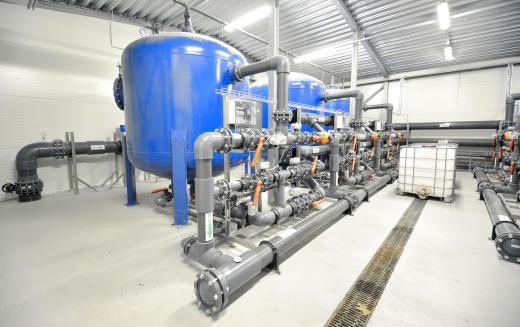Operating pressure is the standard level of pressure a system operates under, usually within a fairly narrow range of tolerances. Many systems ranging from fuel lines in vehicles to space suits are designed to operate under pressure and will not function when there is no pressure. Generally, if the pressure is too low, the system cannot function, and when it is too high, there is a risk of creating an explosion in the system, as the components cannot tolerate the high pressure. Relief valves and other safety measures are used to prevent catastrophic system failures.
On most pressurized systems, a gauge shows the current pressure. It will often highlight operating pressure in green so people know when the system has enough pressure to be operational. Lower pressure may be yellow, alerting people to the fact that either the system is not pressurized yet, or there is a problem of some kind preventing full pressure, like a leak or a shortage of gas. The high pressure zone is often highlighted in red and alarms may illuminate when it passes a certain level.

Pressure can be controlled in a system by a number of means, including using various ways to charge the system to bring it to full pressure, and controlling the flow of pressure with valves. The system is designed to reach and maintain operating pressure unless there is a problem. Some examples of problems can include weak joints, leaks, incorrectly set valves, and other defective components. Pressure can start to get too high under a variety of circumstances. To reduce pressure, valves can be opened to release it, and people can also deenergize the system to stop adding further pressure.
Usually, the manual for a system has information about the normal operating pressure, the maximum working pressure, and the maximum allowable operating pressure. This information can also be printed on a plate on the side of a piece of equipment so people can reference it quickly. One important thing to be aware of is the way pressure can vary, depending on temperature and altitude. With vehicles, for example, people should check and fill the tires when they are cold, rather than after the car has been driven for a while. The hot air from driving can fill the tires and make them appear full when they are not.
If a system is chronically over or under pressurized, this can lead to malfunctions. It is also a sign of an underlying issue that needs to be addressed, and it should be evaluated by a technician to learn more about what is going on.
Ever since she began contributing to the site several years ago, Mary has embraced the exciting challenge of being a About Mechanics researcher and writer. Mary has a liberal arts degree from Goddard College and spends her free time reading, cooking, and exploring the great outdoors.

